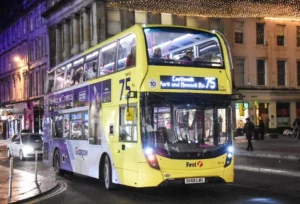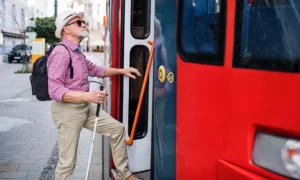By Paul Swinney, Centre for Cities
Policy decisions around public transport should be based on where we need to be, not to where we were pre covid-19.
Will we return to pre-covid levels of activity? Be it office working, high street footfall or public transport usage, it’s a question that has implications for how much commercial property places need, how we use our city centres, and how we run our transport systems.
It is a valid question to ask, but is it now distorting our view of the world?
Public transport usage in the capital
Take public transport. A live policy question, especially in relation to TfL, is how long the taxpayer should continue to support shortfalls in ridership relative to 2019 levels, and whether we should instead get used to a world of lower frequency services.
In London, where pre-covid commuting by public transport was very high (census 2011 data tells us 45 per cent of residents used public transport to get to work, second only to Paris in the European context), it is possible that we may not get back to those levels any time soon. If this does end up being the case then there is an argument to adjust the frequency of services to reflect this (although for the record, I personally think we will, and jobs and amenities will continue to cluster in central London, increasing the number of people coming in even if they come in fewer days per week).
Public transport usage outside of London
For big cities outside of London though, this is the wrong question to be asking. Looking at commuting data (used here as a proxy for overall public transport usage) shows that pre-covid commuting by public transport in large UK cities was low, not only compared to London but to other large European cities. In Manchester and Birmingham, census data from 2011 (the latest available data) tells us that 16 and 17 per cent of commuters respectively used public transport to get to work. Meanwhile in Hamburg, Munich and Berlin, the three German cities closest in size, these numbers were 29, 34 and 35 per cent, respectively.
If Manchester was to increase its share up to the level of these three places, that would be a doubling of its public transport usage and an estimated 170,000 extra commuters on the network. In Birmingham it would be an extra 193,000 commuters. These numbers would be even higher if non-work travel was boosted too.
Transport policy should be driven by long term goals
The size of these figures means that any short-term fall in public transport usage pales into insignificance compared to the headroom for growth. From the perspective of improving how attractive cities are to business investment, tackling air pollution, and hitting net zero goals, this means that policy should not be driven by short term performance but the longer-term goal. Even in a world with more home working, the European city experience reminds us that many more commutes and leisure trips could be done by bus, tram or train.
As Centre for Cities’ research has shown, the difference in public transport usage between these cities is largely shaped by their urban form – higher densities increase demand for public transport over private transport, and so make public transport more viable.
For this reason, increasing public transport ridership in any city wanting to get people out of their cars cannot just be about transport investment. A successful approach will need to marry up investment in their public transport system with housing development. For example, in the UK context this should be done by bringing together the £1.8 billion fund to develop houses on brownfield sites with the City Region Sustainable Transport Settlements, both of which were announced last year. Recent initiatives to cap fares, such as the €9 cap in Germany and the £2 bus fare cap in Greater Manchester, West Yorkshire and Liverpool City Region would help support this.
Policy should increase public transport usage in our cities
As in any crisis, understanding of pre-crisis levels and how quickly we return to them is informative but we should not assume that returning to this position is desirable. In terms of public transport usage in big cities in particular it was not, and policy should be comparing where we are to where we need to be, rather than where we were in 2019. Instead of talking about how to cut services back, we should be looking to double public transport usage in these cities over the next decade.






















